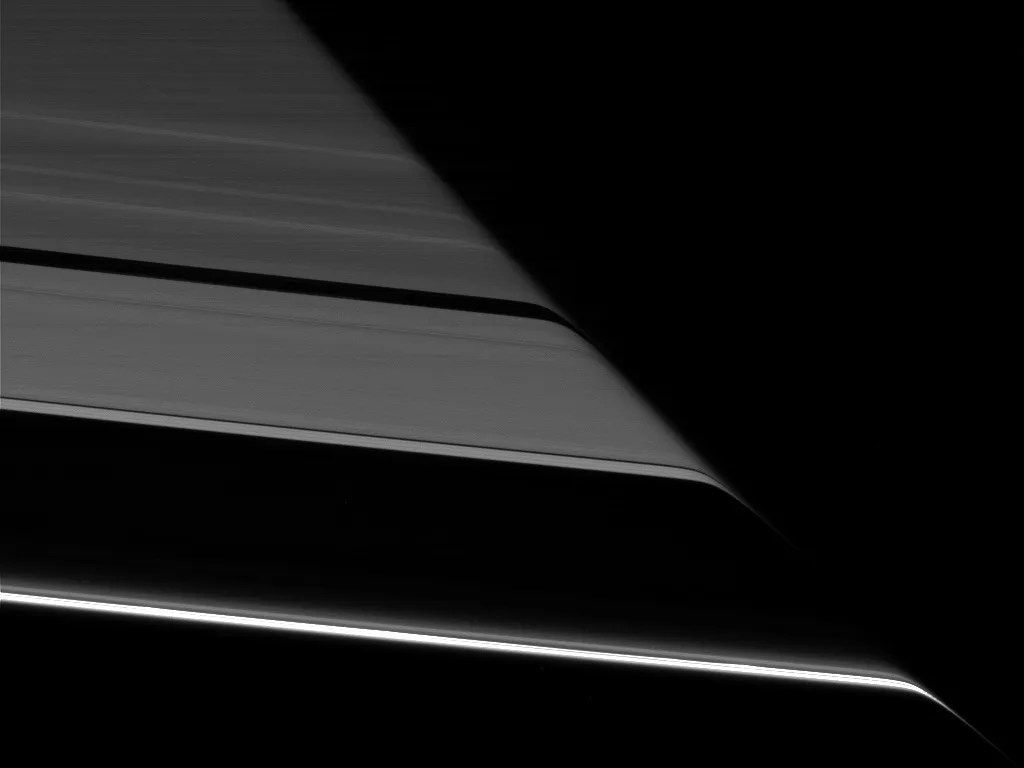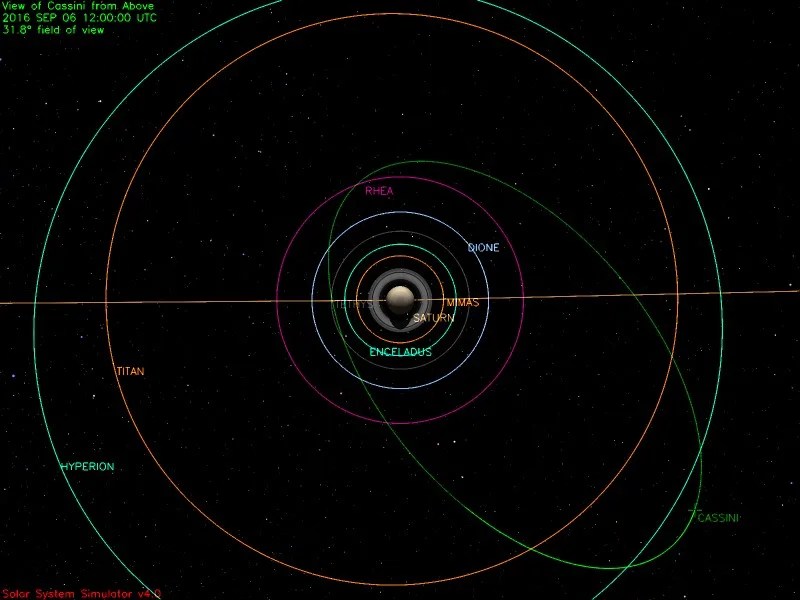6 min read

Cassini spent this week executing some of the final timed commands from its on-board S95 sequence. Commands for 10 weeks of control by the S96 sequence were properly installed in memory, across the distance of 1,502,000,000 kilometers from Earth, courtesy of the Deep Space Network (DSN). Those commands will begin clocking out next week. Work proceeded on preparing the 10-week sequences S97 and S98, and identifying the schedule for S99 work.
Wednesday, Aug. 31 (DOY 244)
The spacecraft travelled southward in its orbit of Saturn today, and crossed through the ring plane. During such crossings, the Radio and Plasma Wave Science (RPWS) instrument typically measures thousands of hits by smoke-particle-size ring particles. After today's crossing, the Visible and Infrared Mapping Spectrometer (VIMS) led a study of Saturn's rings by tracking the red star X Ophiuchi for about 1.4 hours while it cut behind them. The Imaging Science Subsystem (ISS) participated. Since the rings were still nearly edge-on during the stellar occultation, it was ideal for highlighting structures in relatively faint rings such as the C ring.
Next, ISS looked back toward the rings' dark side to observe the region near the Encke gap, in the outer part of the A ring, for 14.6 hours. The Ultraviolet Imaging Spectrograph (UVIS) also observed. This region is home to many giant "propeller" structures (http://go.nasa.gov/17oqTWF), which ISS attempted to reacquire during this observation. At the same time, Cassini coasted through periapsis in its orbit of Saturn #241. The distance and speed were about the same as the previous periapsis passage on Aug. 19. Here is a simulation of Cassini's view looking back northward to the planet: http://go.nasa.gov/2chPTG4. In the illustration, the 325-km wide Encke gap appears as the dark line seen touching the "C" in "UTC" at the upper left.
Finally today, the Composite Infrared Spectrometer (CIRS) spent three hours mapping thermal emissions from the rings at a variety of phase and elevation angles. UVIS rode along.
Thursday, Sept. 1 (DOY 245)
ISS pointed towards the unlighted side of Saturn's main rings again. In an observation lasting two hours, ISS used using multiple color filters, while the elevation and phase angle were changing. The results will be used to learn about the phase function of rings particles, and their albedo. CIRS, UVIS, and VIMS rode along.
Next, the Sun appeared to pass behind Saturn's narrow, complex F ring, from Cassini's moving perspective. From the vicinity of Saturn, which is approximately 10 times farther away from the Sun than the Earth is, our star appears about 1/100 as bright as when seen from home. VIMS observed the solar occultation, which proceeded to backlight not only the dusty F ring, but all the way in to the middle of the C ring, where the line of sight to the Sun then turned around and moved radially back outward. The whole observation lasted 10.25 hours, and UVIS rode along with the latter part of it. VIMS used its solar port, to avoid having to point the other telescopes directly at the Sun. Solar ring occultations like this are useful to study the size and spatial distributions of the smallest particles in the rings. These light up especially brightly in forward-scattered sunlight.
Friday, Sept. 2 (DOY 246)
VIMS continued dictating spacecraft pointing, and turned to track the bright red star Alpha Orionis, better known as Betelgeuse, for just under four hours. This stellar occultation covered the A ring and the Cassini Division on ingress. The line of sight then turned around in the most opaque portion of the B ring. The rings were again sampled by starlight at different longitudes during egress. Finally, while Cassini was speeding northward towards another ring plane crossing, ISS took advantage of the low elevation angle and observed Saturn's outer, fainter rings for the next 11 hours. UVIS and VIMS rode along.
Saturday, Sept. 3 (DOY 247)
VIMS took over again and watched the edge-on rings for another eight hours, during which Cassini coasted through the ring plane going north. This provided data for a more precise determination of the narrow F ring's inclination, with CIRS and UVIS also taking observations. Capping off the day’s observations, the Cosmic Dust Analyzer (CDA) directly sampled particles in Saturn's diffuse E ring (the vast ring created by Enceladus's geysers) while Cassini was in the vicinity of Titan's orbit. The goal is to understand the interaction between the E ring grains and Saturn's largest moon.
Sunday, Sept. 4 (DOY 248)
For nearly 14 hours, UVIS made high-resolution observations of Saturn in the extreme- and far-ultraviolet part of the spectrum, studying the distribution of hazes and organics in the northern hemisphere. CIRS and ISS rode along.
The flight team sent up commands comprising the S96 sequence, which will take control of Cassini starting Sept. 8 and run for 10 weeks. All the Instrument Expanded-Block commands had already been uplinked and confirmed on board.
Monday, Sept. 5 (DOY 249)
CIRS watched Saturn for 22 hours while the planet rotated twice on its polar axis. Mapping at mid-infrared wavelengths, this observation measured temperatures in the upper troposphere and tropopause. ISS and VIMS rode along.
Several Cassini scientists volunteered their time to attend the DragonCon convention in Atlanta, Georgia over the U.S. Labor Day holiday weekend, to give a wide variety of talks on Solar System Exploration. Turnout was at full capacity for many of their talks.
Today's featured image of the unlit side of Saturn's rings offers brilliant examples of atmospheric refraction as well as sunlight being forward-scattered from very fine particles: /resources/17494 .
Tuesday, Sept. 6 (DOY 250)
CIRS stared at Saturn's northern hemisphere for nearly one planet-rotation period today, capturing infrared spectra to study its atmospheric composition. UVIS and VIMS rode along. This eight-hour observation was in progress when Cassini coasted through apoapsis, marking the start of Saturn Orbit #242. Altitude and speed were about the same as during the previous apoapsis, on Aug. 25.
Next, UVIS observed Saturn’s northern aurora for eight hours, with VIMS, ISS, and CIRS riding along.
The Deep Space Network communicated with and tracked Cassini via five sessions this week, using stations in California and Australia. A total of 13,958 individual commands were uplinked, and about 795 megabytes of telemetry data were downlinked and captured at rates as high as 142,201 bits per second.
Wrap up:
Cassini is orbiting Saturn with a period of 12 days in a plane inclined 53.7 degrees from the planet's equatorial plane. The most recent spacecraft tracking and telemetry data were obtained on Sept. 6, using one of the 34-meter diameter DSN stations in Australia. The spacecraft continues to be in an excellent state of health with all of its subsystems operating normally except for the instrument issues described at http://saturn.jpl.nasa.gov/anomalies
Cassini's path up to mid-day Sept. 6 is illustrated here: http://go.nasa.gov/2cpI5zv.
Milestones spanning the whole orbital tour are listed here: https://saturn.jpl.nasa.gov/mission/saturn-tour/tour-dates .
Information on the present position and speed of the Cassini spacecraft may be found on the "Present Position" page at:
https://saturn.jpl.nasa.gov/mission/saturn-tour/where-is-cassini-now .








